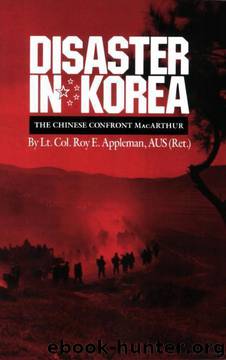Disaster in Korea by Roy E Appleman

Author:Roy E Appleman [Appleman, Roy E]
Language: eng
Format: epub
Published: 2011-11-27T13:36:00+00:00
When Eighth Army ordered its corps and divisions to withdraw from the Chongchon River front, General Keiser prepared to move the 2nd Division CP southward. For his new CP he selected a point on the Kunu-ri-Sunchon road about four miles south of the junction of that road with the Kunu-ri-Anju road. The 2nd Division's zone of responsibility, and also IX Corps's, on the west included the road south from the junction to Sunchon and the flanking-ridges west of it. The new division CP opened in a small schoolhouse about 5 A.M. on 29 November. It was still dark at the time.
The division headquarters staff had just arrived there, said Lt. Col. Maurice Holden, the division operations officer (G-3), "when some members of the Turkish Brigade arrived at the command post breathlessly and informed us that there was a road block several miles south of our CP on the Sunchon road." That was the first information the 2nd Division staff had that an enemy roadblock existed on the planned withdrawal route. The division staff was inclined not to credit the report fully, as they had received unreliable reports from the Turkish Brigade in the past several days during its first combat in Korea and considered the brigade somewhat excitable. Nevertheless, the staff took steps to learn what the situation to the south really was.
The division provost marshal, Lt. Col. Henry C. Becker, sent a military-police patrol at daybreak to investigate the report. Sometime between eight and nine o'clock, Lieutenant Colonel Becker reported to the division that the patrol had been "knocked out" and several of its members killed. This incident was said to have taken place three to four miles south of the division CP. Thus, the division CP knew definitely by 9 A.M. on 29 November that an enemy roadblock existed south of it on the Sunchon road.'
Upon receiving the report from Lieutenant Colonel Becker, the division decided to send Captain Kydland and his 2nd Reconnaissance Company south to open the road. Kydland had a reputation in the division as a battle-experienced officer, capable and dependable. The enemy were reported to be in a fireblock position; that is, the CCF were in firing positions with small arms and automatic weapons on both sides of the road. There was no physical roadblock on the road itself. Lieutenant Colonel Becker's MP patrol had determined this point. When the Reconnaissance Company reached the fireblock area, enemy fire almost immediately wounded Captain Kydland. A flash message to the division CP informed it that Kydland would have to be evacuated. By noon the division received further word that the Reconnaissance Company had failed to remove the enemy fireblock and that more strength was needed. General Keiser then ordered Colonel Peploe to send a rifle company from the 38th Infantry to reinforce the Reconnaissance Company. As stated earlier, Peploe sent C Company. It arrived at the division CP about 2 P.M. The company, seriously reduced by previous casualties, numbered only 60 to 75 men, less than half strength.
Download
This site does not store any files on its server. We only index and link to content provided by other sites. Please contact the content providers to delete copyright contents if any and email us, we'll remove relevant links or contents immediately.
| Automotive | Engineering |
| Transportation |
Whiskies Galore by Ian Buxton(41935)
Introduction to Aircraft Design (Cambridge Aerospace Series) by John P. Fielding(33085)
Small Unmanned Fixed-wing Aircraft Design by Andrew J. Keane Andras Sobester James P. Scanlan & András Sóbester & James P. Scanlan(32763)
Craft Beer for the Homebrewer by Michael Agnew(18194)
Turbulence by E. J. Noyes(7977)
The Complete Stick Figure Physics Tutorials by Allen Sarah(7334)
Kaplan MCAT General Chemistry Review by Kaplan(6897)
The Thirst by Nesbo Jo(6877)
Bad Blood by John Carreyrou(6581)
Modelling of Convective Heat and Mass Transfer in Rotating Flows by Igor V. Shevchuk(6406)
Learning SQL by Alan Beaulieu(6235)
Weapons of Math Destruction by Cathy O'Neil(6206)
Man-made Catastrophes and Risk Information Concealment by Dmitry Chernov & Didier Sornette(5951)
Digital Minimalism by Cal Newport;(5699)
Life 3.0: Being Human in the Age of Artificial Intelligence by Tegmark Max(5506)
iGen by Jean M. Twenge(5384)
Secrets of Antigravity Propulsion: Tesla, UFOs, and Classified Aerospace Technology by Ph.D. Paul A. Laviolette(5330)
Design of Trajectory Optimization Approach for Space Maneuver Vehicle Skip Entry Problems by Runqi Chai & Al Savvaris & Antonios Tsourdos & Senchun Chai(5036)
Pale Blue Dot by Carl Sagan(4949)
